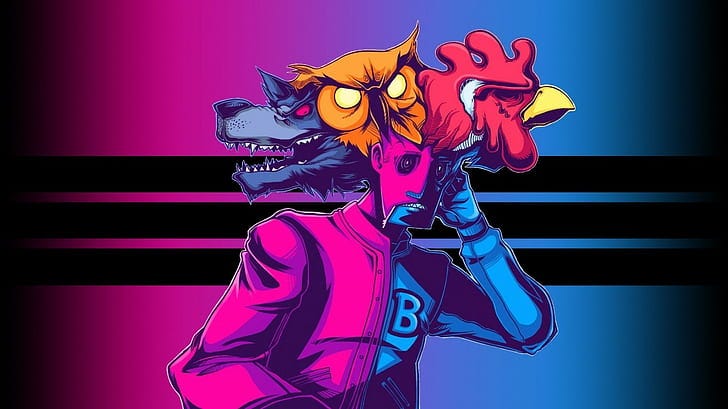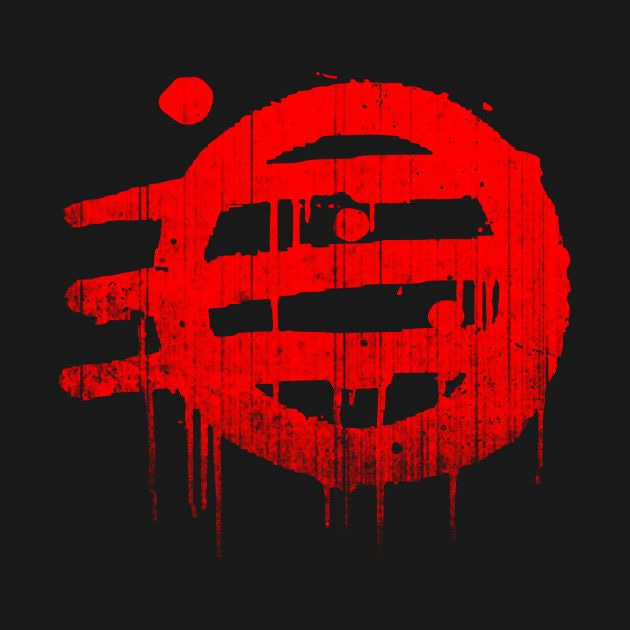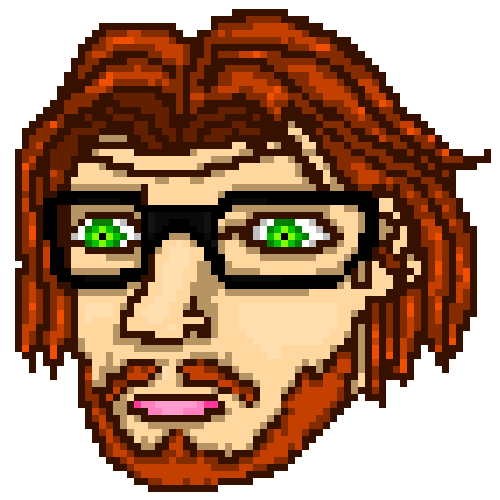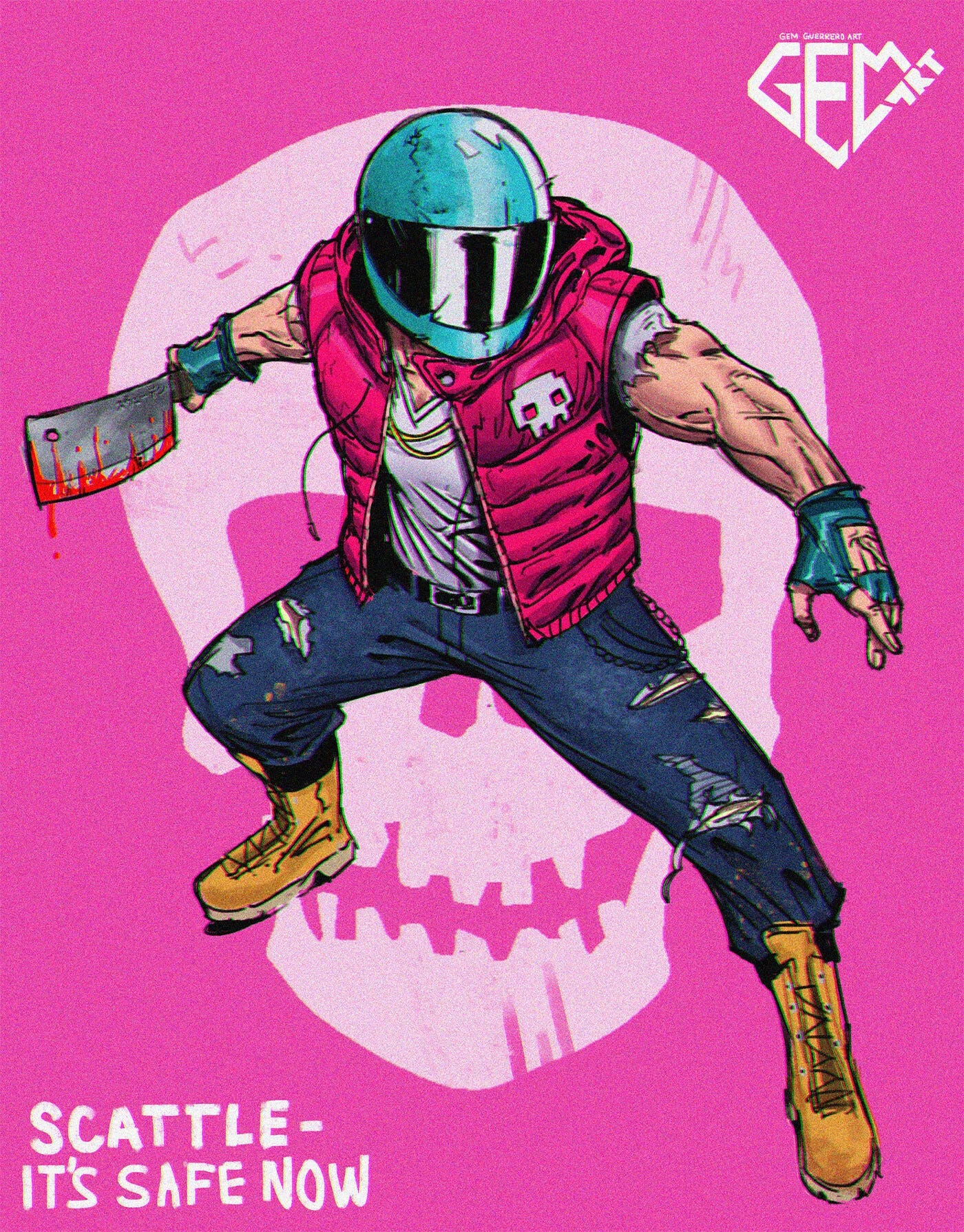I think our time is up... But we'll meet again. Before you go, here's four questions to ponder:
Question number one: Do you like hurting other people?
Question number two: Who are leaving messages on your answering machine?
Question number three: Where are you right now?
And the final question: Why are we having this conversation? That's all for now. See you soon...
This blog post comes with a backing song.1 Actually, a whole soundtrack of them. Actually actually, two whole soundtracks.
I keep getting these strange messages on my answering machine. Like just the other day, some strange voice, no idea who it was, left this.
"Good evening! This is 'Blake' speaking. We have a job for you. There's a power outage... Over on 24th NE St. We want to take care of it. We already sent someone over a while ago... But it seems he didn't do a very good job. Head over there right away! They're expecting you. Keep it quick and clean!"
Who even has an answering machine anymore? Everybody, because it’s April 3rd, 1989.
Hotline Miami is an excellent indie game that came out in 2012, taking place in 1980s Miami in an alternate history where the cold war got hot. There will be plot spoilers, although this is a plot where spoiling it won’t really ruin the fun, so it’s alright. Russia invades Hawaii and there is conventional warfighting which ends when San Francisco gets nuked off the face of the earth.2 A few years later, both sides, terrified at the prospect of nuclear war, a group called the Russo-American Coalition forms, dedicated to bringing the two nations together and ending hostilities.
However, many patriotic Americans are not happy with this, as they hate the Russians. A group of high ranking military generals form an organization called 50 Blessings, and start recruiting patriots to their newsletter. Once one signs up for this newsletter, they receive a box with a rubber animal mask inside. Then, they start receiving strange phone calls, telling them to do “deliveries” to certain locations. They arrive at the locations, seeing them tagged with the 50 Blessings symbol, and their mission is to kill everything inside. If they don’t, bad things will happen.
Hotline Miami follows3 one of their killers, an unnamed man that we refer to as “Jacket”, for obvious reasons.
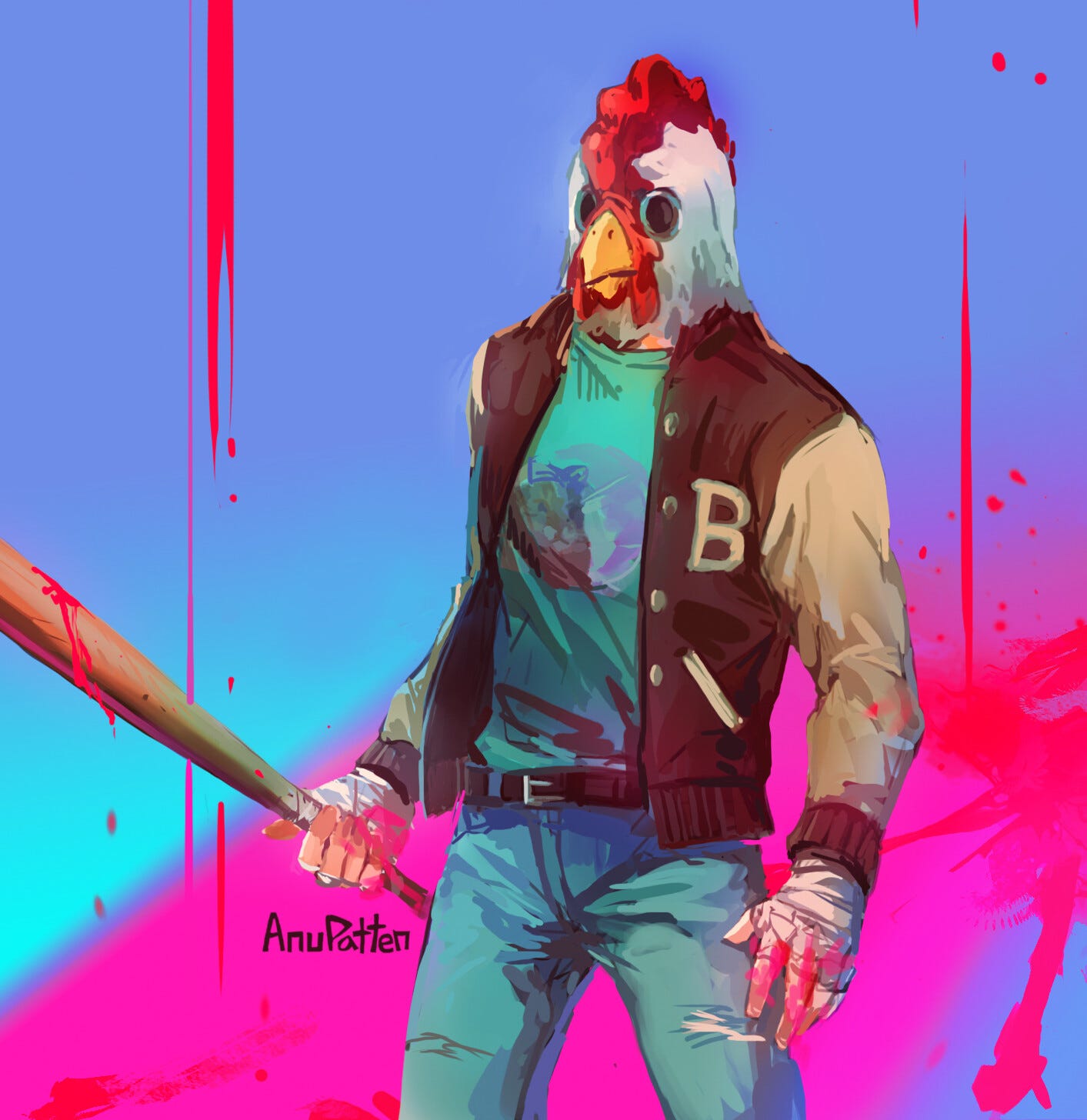
Jacket carries out a series of hits against the Russian mafia in Miami on behalf of 50 Blessings, but the story is not what it seems.
There are two things to highlight about Hotline Miami. The first is that the gameplay is just really fun. It’s tight, action-packed, has a very distinct, trippy 80s aesthetic, and a bitchin’ awesome soundtrack. The energy is high, almost frantic.
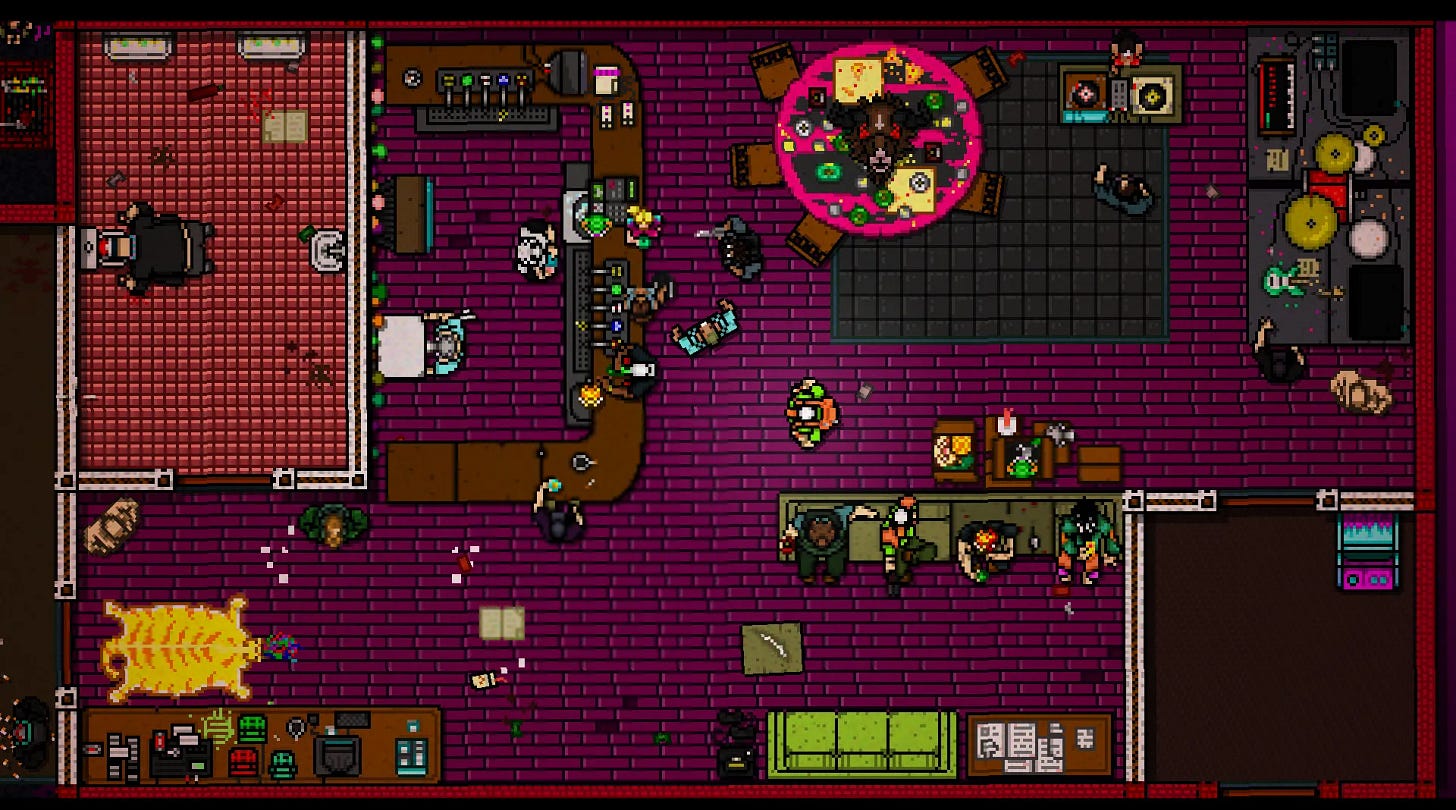
The mechanics are really simple. You can punch and knock guys out. You can execute guys who are knocked out. You can grab melee weapons to kill guys. You can grab guns to kill guys at a distance, but watch out, the sound will draw attention.
The enemies are very simple, too. There’s Henchmen, who basically have the same moveset as you. They have either melee weapons or guns, and if they see you, they’ll attack. Sometimes they sit still, sometimes they patrol. One hit kills them. Then there’s dogs, who you cannot hurt with your fists, so I hope you’ve got a weapon on you. And thugs,4 who you can only hurt with gunfire, so I hope you don’t draw too much attention to yourself while taking them out. There are also a handful of boss battles, with relatively unique mechanics, but at the end of the day, a guy is a guy, one blow to the head will end him.
Despite the small and simple set of mechanics, enemies, and actions, they do a really great job of setting up the levels to really exercise all of the possibilities these reveal. This becomes especially apparent after I just replayed both Hotline Miami and it’s sequel this weekend. The sequel adds some more of everything, but, it’s not great. The extra mechanics don’t get a lot of game time, so you get to play with them once and then they’re gone. And most of them aren’t really that fun or interesting. The sequel is worth playing if you liked the first game, but the first game is better.
But the thing that really makes Hotline Miami shine, the thing that I didn’t even consciously recognize the first time I played it,5 is the environmental storytelling.6
There is actually a fairly rich lore in this game, but you will miss all of it if you aren’t paying attention. For example, the first time I played through this game, I didn’t realize that in the story, I wasn’t the only killer. But when I played it again on Saturday, I started to pay more attention to the levels as I was playing them. Most of the levels have another 50 Blessings agent in them, either dead in a room somewhere, or held prisoner. If they’re still alive, you end up killing them as a side effect of completing your mission.
A lot of the story is implied by the visual environment of the levels you fight in, as well as the between-the-lines meanings of the specific text of your phone messages.
Every level starts with both an intro and an outro. The intro consists of Jacket, in his apartment, listening to his phone messages. If you pay close attention to his apartment, you will see that between each level, it changes, reflecting developments of the story. You will also see various newspaper clippings on his table, which, if you read them, highlight the outside world’s perception of his actions and add quite a bit of nuance to the story.
The outro consists of Jacket going to various locations, bars, pizza joints, video rental joints, and picking things up. No matter where he goes, the cashier is always the same character, a character the fans call “Beard”
Beard acts very familiar with Jacket, as if they are long friends. But as the game progresses, the things he says get stranger and stranger.
Periodically throughout the game, you will have “dream sequences” where you are in a room speaking to three characters, each with a different mask. Don Juan, a gentle, seductive woman with a horse mask. Rasmus, an asshole who hates you, with an owl mask. And Richard, a mysteriously threatening man in a rooster mask who portends doom for you. The dialogue in this post’s cold open is Richard’s dialogue to you in one of the scenes.
As the game progresses, you will eventually complete a mission where, instead of returning to your house, you receive another phone call at the mission location, telling you to go somewhere else. When you arrive, you will find every person in the building murdered, and on the second floor, you encounter the other player character, Biker.
This functions as a boss battle, and you quickly grab some golf clubs and beat him to death.
After that mission, you start seeing visions of a strange man who tells you that you’ve fucked up. Richard starts getting more threatening, and Beard is replaced with the zombie corpses of the henchmen you’ve killed.
A few missions later, when you return to your apartment, you find the strange man sitting on your couch, and your girlfriend (a prostitute you rescued in an earlier mission) dead. The man, Richter, tells you that you failed to kill Biker, and shoots you in the head, and you wake up in a hospital.
PSYCH. The whole game so far was a coma dream, you remembering (incorrectly) the things you’ve done. Don Juan, Rasmus, and Richard, were all in your head. Beard died years ago, in the San Francisco incident. The rest of the game consists of you breaking out of the hospital, breaking into the police station, and either killing, or beating-and-sparing Richter.7
After beating and sparing Richter, you go the mansion where the Russian mafia boss lives. For some reason, you think he’s responsible for the phone calls. You break in, kill everyone, and murder the Russian mafia boss. Afterwards, in a dramatic scene, you stand on the balcony and throw your Richard mask to the wind.
And then the game bursts with Dream Static,8 and “rewinds” a month, showing you Biker’s plot line. Biker was another person blackmailed into murdering for 50 Blessings. He wanted out, and started putting off missions in order to investigate the phone calls instead. He eventually ends up at the building where Jacket fights him, a phone company complicit in the calls. But he remembers the battle differently. He remembers killing Jacket instead.
And that’s pretty much the game. It’s a action-packed violence fest but, if you pay close attention to the plot via the environmental storytelling, you’ll realize that the actual message of the game is “violence is bad, and does not end well for anyone”.
But when the game first came out, in 2012, a lot of people did not pick up on that message. They simply enjoyed the game. So, even though they didn’t really want to, they made a sequel.
From a game perspective, the sequel is fine, but not great. The level design feels phoned in, the controls got jankier, and the difficulty is spiky, less consistent, and sometimes “unfair”9
The first time I played the sequel, just like the first time I played the original, most of the plot went over my head. I wasn’t paying close enough attention. The sequel ties off every plot line, in a very strict way that, on second playthrough, reeks of “they’re ending it definitively, because they’re pissed off that everyone was mad at the ambiguous ending of the first game, and now they can’t make a third game”.
The second game, plot-wise, jumps around in time, and follows a few different groups of people. One segment follows Beard and Jacket when they were special forces operatives in a conventional war against Russia, years before the events of the first game.
Another plot line follows a detective, who is actually doing more murders, for no reason other than he’s fucked in the head. This plot line seems entirely irrelevant to me.
Another plot line follows a journalist trying to get to the real story of the first game. He ends up in over his head in several levels. A neat attention to detail is that, on his levels, he cannot use lethal weapons, and when he hits enemies, they don’t die, they just pass out. He is not a killer.
Another plot line follows “The Son”, the son of the Russian mafia boss you killed, who is trying to rebuild the criminal empire.
And the final plot line follows “The Fans”, a group of people who paid attention to the news around Jacket’s exploits in the first game, thought it was awesome, and start doing their own thing in the same vein.
The story in the second game is not nearly as interesting, and is communicated a lot more explicitly instead of environmentally. But there are a few cool elements. The Fans go after the Russian Mafia, and so you see two different perspectives of those events. The middle mission, ending the fans’ plot line, sees them storming the Russian mafia headquarters. But the finale, ending the Son’s plot line, sees the Son tripping balls on new designer drugs, rampaging through his own headquarters, and personally killing all of the fans as they raid his headquarters.
An interesting element that I did not pick up on at all, until some Youtube video essays pointed it out, is that The Fans are a metaphor for the literal fans, in the real world, of the first game. They are supposed to represent the people who played the first game, thought it was fun and awesome, and missed the point of the plot. The Fans’ plot line (in their own mission) ends very anticlimactically, with The Son just showing up and shooting them in the head. The message is clear: don’t be fuckin stupid. This isn’t cool. If you think violence is cool, one day someone’s just going to casually dispatch you and your life will have meant nothing.
In fact, almost every player character dies at the end of their plot line, in very anti-climactic fashions, to really hammer this home. And when I say every character, I mean every character. The game plot ends with 50 Blessings succeeding in their mission. The Russian and American presidents are at a conference together with the Russo-American Coalition, when 50 Blessings operatives kill them both. Russia interprets this as an act of war, and starts a total nuclear exchange. By the end of Hotline Miami 2, every character dies in nuclear hellfire. “Fuck you, every story line is over, we’re not making a third game”.
And that, in a spoiler-filled nutshell, is Hotline Miami. As a game, it’s incredibly fun, tight action-packed gameplay with a soundtrack that will amp you up. Aesthetically, it’s very unique, and the art and music are great. The story is not all that deep, but it’s told extremely well through environmental storytelling. It’s told in a way where you’ll miss the entire plot if you’re not paying attention, but if you are, you’re rewarded with the details. And, despite being a game so violent that it was made illegal in Australia, a keen-eyed reading of its story sends the clear message that violence is actually bad, and you will reap what you sow.
The game isn’t that long. Hotline Miami has like 20 levels, each level will only take you ten minutes, max. The sequel has a few levels that will take you longer, mostly because they’re Nintendo-hard10 and you’ll have to retry them dozens of times, but both games collectively will likely not take more than a dozen hours to finish. I started replaying them on Friday afternoon and finished at 1pm on Sunday.
Honestly, the game is worth it just for the soundtrack.
And, of course, if your answer to Richard’s first question is “yes”, this game has enough blood, gore, and murder, to give you your fill.
Fun fact: I was going to see Carpenter Brut live, but I had to miss the show, because that was the week that my girlfriend I thought I was going to marry, left me.
Wouldn’t that be amazing
Mostly
All other characters are white, but the thugs are all black. Sometimes it’s hilarious when Europeans make games set in America. Despite their moral preening, they are constantly inadvertently “racist”
The first time I played it was like a month after I got a medical weed card, so, thinking was muted, so to speak.
This here’s a theme in the games I like.
Canonically, per the sequel, you spared him
“Dream Static” is when the game uses VHS static visual effects to imply that what you are seeing is not necessarily real
There was one level where I had to abuse a bug in the game to finish it, it was too hard otherwise.
“Nintendo-Hard” is a euphemism for games that are hard in a frustrating or unfair way, like many old NES games were



